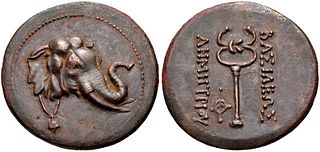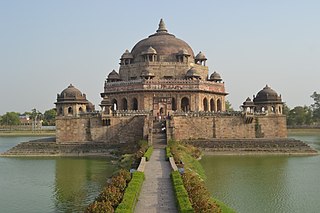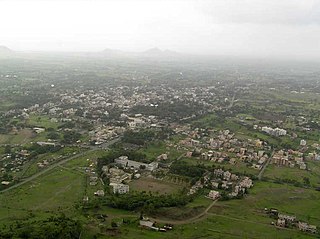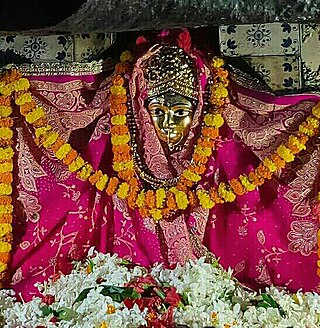Related Research Articles
The Gupta Empire was an ancient Indian empire on the Indian subcontinent which existed from the mid 3rd century CE to mid 6th century CE. It was the seventh ruling dynasty of Magadh. At its zenith, from approximately 319 to 467 CE, it covered much of the Indian subcontinent. This period has been considered as the Golden Age of India by historians, although this characterisation has been disputed by some other historians. According to Puranic chronology the Imperial Gupta dynasty ruled for 245 years from 327 B.C.-82 B.C., while according to the currently accepted chronology the regnal period of this dynasty is 209 years from 319 A.D.-528 A D. The ruling dynasty of the empire was founded by Gupta and the most notable rulers of the dynasty were Chandragupta I, Samudragupta, Chandragupta II, Kumaragupta I and Skandagupta.

The word Yona in Pali and the Prakrits, and the analogue Yavana in Sanskrit and Yavanar in Tamil, were words used in Ancient India to designate Greek speakers. "Yona" and "Yavana" are transliterations of the Greek word for "Ionians", who were probably the first Greeks to be known in India.

The Indo-Greek Kingdom, or Graeco-Indian Kingdom, also known historically as the Yavana Kingdom (Yavanarajya), was a Hellenistic-era Greek kingdom covering various parts of modern-day Afghanistan, Pakistan and northwestern India. This kingdom was in existence from c. 200 BC to c. 10 AD.

Sasaram, also spelled as Shahsaram, is a historical city and a municipal corporation region in the Rohtas district of Bihar state in eastern India.

The Gahadavala dynasty also Gahadavalas of Kannauj was a Hindu Rajput dynasty that ruled parts of the present-day Indian states of Uttar Pradesh and Bihar, during 11th and 12th centuries. Their capital was located at Banaras in the Gangetic plains, and for a brief period, they also controlled Kannauj.

The Kachhwaha, or Kachhawa is a Rajput clan found primarily in India.
Telugu Brahmins are Telugu-speaking Brahmin communities native to the Indian states of Andhra Pradesh and Telangana. They fall under the Pancha Dravida Brahmin classification of the Brahmin community in India. Telugu Brahmins are further divided into sections like Vaidiki, Niyogi, Deshastha, Dravida, Golkonda Vyapari among others.

Junnar is a city in the Pune district of the Indian state of Maharashtra. The city has history dating back to the first millennium. The nearby fort of Shivneri was the birthplace of Maratha king Shivaji, the founder of the Maratha Empire. Junnar was declared the first tourism taluka in Pune district by the government of Maharashtra on 9 January 2018.

The Hathigumpha Inscription is a seventeen line inscription in a Prakrit language incised in Brahmi script in a cavern called Hathigumpha in Udayagiri hills, near Bhubaneswar in Odisha, India. Dated between the second century BCE and the first century CE, it was inscribed by the Jain king Kharavela of the Kalinga kingdom.

The Rohtasgarh or Rohtas Fort is located in the Son River valley, in the small town of Rohtas in Bihar, India.
Kharwar is a community found in the Indian states of Uttar Pradesh, Bihar, Jharkhand, Chhattisgarh, Orissa and West Bengal.

Maa Tara Chandi Temple is a Hindu temple dedicated to Maa Shakti or Maa Durga, located in Sasaram, Bihar, India. It is one of the 51 Shakti Peetha.
Chandradeva, also known as Chandraditya, was an Indian king from the Gahadavala dynasty. He ruled the Antarvedi country in present-day Uttar Pradesh, including Kanyakubja and Varanasi.
Madana-pala, also known as Madana-chandra, was an Indian king from the Gahadavala dynasty. He ruled the Antarvedi country in present-day Uttar Pradesh, including Kanyakubja and Varanasi.
Vijaya-chandra was an Indian king from the Gahadavala dynasty. He ruled the Antarvedi country in the Gangetic plains, which includes a major part of the present-day eastern Uttar Pradesh, including Varanasi. He probably also ruled some parts of western Bihar through his feudatories. He is believed to have repulsed a Ghaznavid invasion.

The Kalachuris of Ratnapura were a central Indian dynasty during 11th and 12th centuries. They ruled parts of present-day Chhattisgarh from their capital at Ratnapura. They were an offshoot of the Kalachuris of Tripuri, and ruled as vassals of the parent dynasty for many years.
The Yavanarajya inscription, also called the Maghera Well Stone Inscription, was discovered in the village of Maghera, 17 kilometers north of Mathura, India in 1988. The Sanskrit inscription, carved on a block of red sandstone, is dated to the 1st century BCE, and is currently located at the Mathura Museum in Mathura. The inscription notes the donation of a water well and tank to the community in 1st century BCE, built by a Brahmana.
The Khayaravala dynasty, was a tribal kingdom that ruled parts of the present-day Indian states of Bihar and Jharkhand, during the 11th and 12th centuries. Their capital was located at Khayaragarh in Shahabad district. The dynasty ruled the Japila territory as feudatories of the Gahadavala dynasty of Varanasi. This is demonstrated by inscriptions which show land grants being made to the Khayaravalas.
Pratap Dhavala was Khayaravala king in 12th century. There are inscription of Pratapdhavala in Phulwaria, Tutrahi fall rock inscription of Vikram Samvat 1214, Tarachandi rock inscription of Vikram Samvat 1225.
Baghdeo Singh was founder of Ramgarh Raj in North Chotanagpur. He was king of Khayaragarh. He was made Fauzdar of Karra under the Nagvanshi. He suppressed rebellion in Tamar for Nagvanshi ruler. Nagvanshi send him to extract taxes from Karpurdeo the king of Karnpura. Baghdeo killed Karpurdeo and he declared himself as the King of that region.
References
- ↑ Prabhu, T. L. (4 August 2019). Majestic Monuments of India: Ancient Indian Mega Structures . Retrieved 22 December 2019.
- ↑ Prakash, Gyan (30 October 2003). bonded Histories: Genealogies of Labor Servitude in Colonial Indiaq. ISBN 9780521526586 . Retrieved 22 December 2019.
- ↑ Ranjan, Manish (19 August 2002). Jharkhand Samanya Gyan. ISBN 9789351867982 . Retrieved 22 December 2019.
- ↑ Niyogi, Rama (1951). "The Khayaravāla Dynasty". Proceedings of the Indian History Congress. 14: 117–122. JSTOR 44303949.
- ↑ Niyogi 1951, p. 119.
- ↑ Niyogi 1951, pp. 118–119.